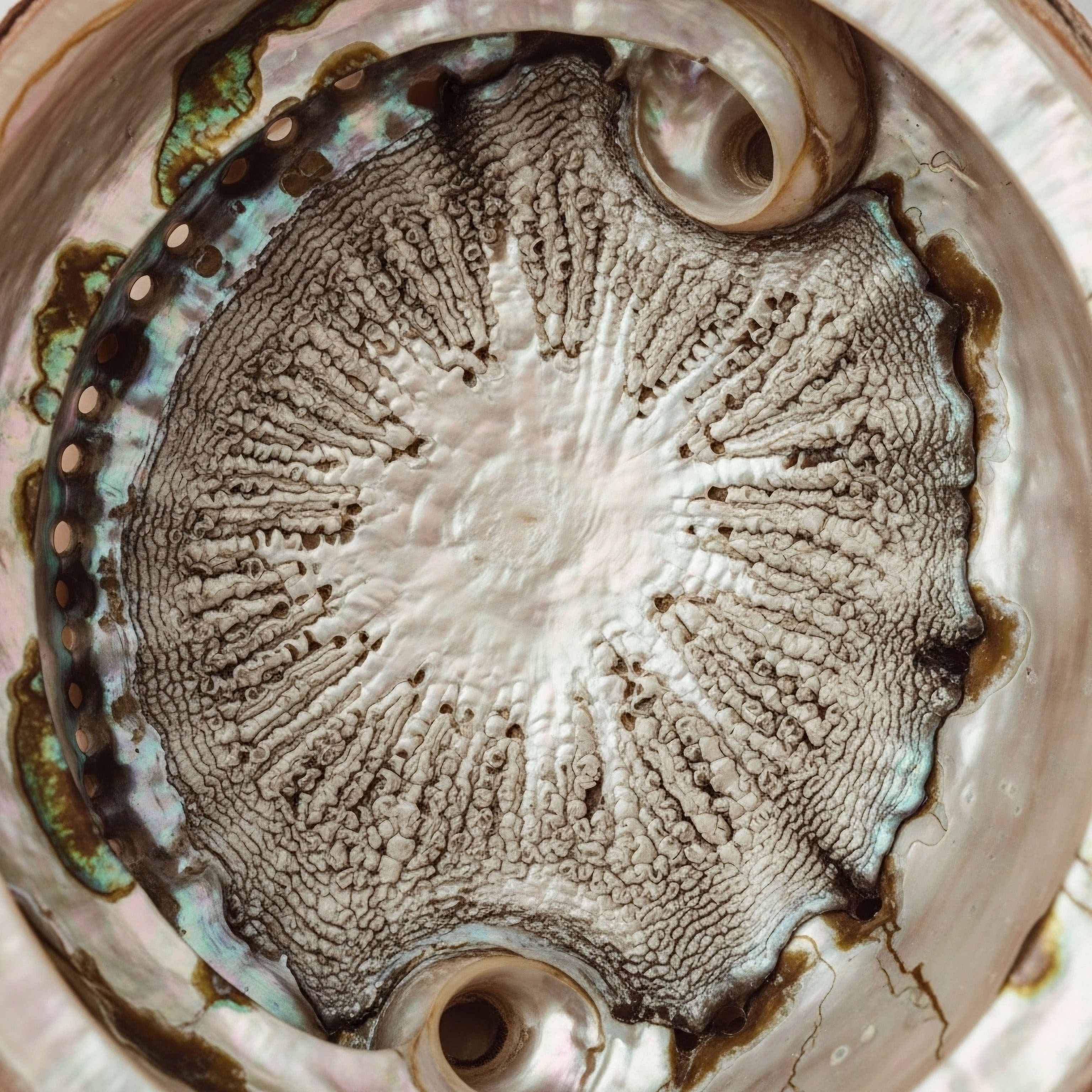

Fundamentals
Have you ever felt a subtle shift in your vitality, a quiet whisper from your body suggesting that something is not quite aligned? Perhaps it manifests as a persistent fatigue, a gradual decline in your physical resilience, or a sense that your internal systems are simply not operating with their accustomed precision.
These experiences are not merely isolated symptoms; they often represent deeper conversations occurring within your biological landscape, particularly within the intricate world of your hormones. Understanding these internal dialogues is the first step toward reclaiming your full potential and restoring a sense of balance.
Among the many chemical messengers orchestrating bodily functions, insulin-like growth factor 1 (IGF-1) holds a significant position. This polypeptide hormone, structurally similar to insulin, plays a central role in growth, development, and tissue repair throughout life. It acts as a primary mediator of the effects of growth hormone (GH), stimulating systemic body growth and exerting anabolic effects on nearly every cell type.
IGF-1 is predominantly produced by the liver in response to GH, yet local production occurs in various tissues, highlighting its widespread influence.
The concept of growth factors might seem abstract, yet their actions are profoundly personal. Imagine IGF-1 as a conductor in your body’s cellular orchestra, signaling cells to grow, divide, and survive. This signaling is essential for maintaining tissue integrity, supporting muscle mass, and facilitating recovery from physical exertion. When this conductor is out of tune, either playing too loudly or too softly, the entire symphony of your health can be affected.
For instance, a decline in youthful vigor, a reduction in muscle tone, or a slower recovery from exercise might prompt a consideration of your growth hormone and IGF-1 status. Conversely, an unexplained acceleration of certain cellular processes or a persistent feeling of metabolic imbalance could also point to an altered IGF-1 dynamic. Recognizing these subtle cues from your body allows for a more informed exploration of your internal environment.
IGF-1, a key hormonal messenger, orchestrates cellular growth and repair, influencing vitality and physical resilience.
The body’s hormonal systems operate through sophisticated feedback loops, much like a finely tuned thermostat. When growth hormone is released from the pituitary gland, it prompts the liver to produce IGF-1. This IGF-1 then circulates, exerting its effects on target cells, and also provides a feedback signal to the hypothalamus and pituitary, influencing further GH secretion.
This regulatory mechanism ensures that IGF-1 levels are typically maintained within a specific range, crucial for optimal physiological function. However, various factors, including age, lifestyle, and underlying health conditions, can disrupt this delicate equilibrium.
Considering the question of specific cellular risks associated with elevated IGF-1, it becomes clear that balance is paramount. While IGF-1 is indispensable for healthy growth and tissue maintenance, persistently high levels can alter cellular behavior in ways that warrant careful consideration. This involves understanding how cells respond to sustained growth signals and the potential implications for long-term health. Our exploration will move beyond simple definitions, examining the intricate connections between IGF-1, other endocrine pathways, and overall well-being.
The body’s systems are interconnected, a complex web where a change in one area can ripple throughout the entire network. For example, the relationship between IGF-1 and metabolic function is particularly noteworthy.
While low IGF-1 levels have been associated with increased risk of metabolic syndrome and insulin resistance, suggesting a protective role for adequate IGF-1 in these contexts, the implications of elevated levels extend to other cellular processes. This duality underscores the importance of a comprehensive perspective when evaluating hormonal health.
Understanding your own biological systems is an empowering act. It transforms vague symptoms into actionable insights, allowing you to partner with clinical science to reclaim vitality and function without compromise. This journey begins with recognizing the profound impact of molecules like IGF-1 on your daily experience and long-term health trajectory.


Intermediate
Moving beyond the foundational understanding of IGF-1, we now consider the specific clinical protocols and therapeutic agents that interact with this vital growth factor. The precise regulation of IGF-1 is a cornerstone of metabolic health and cellular integrity, and various interventions aim to optimize its activity, either directly or indirectly. This section will clarify the mechanisms by which these protocols influence IGF-1, detailing the ‘how’ and ‘why’ of their application.
The growth hormone (GH) and IGF-1 axis is a central regulatory pathway. GH, secreted by the pituitary gland, stimulates the liver to produce IGF-1, which then mediates many of GH’s anabolic effects. Therefore, interventions that modulate GH secretion will inherently influence IGF-1 levels.

Growth Hormone Peptide Therapy and IGF-1 Modulation
Growth hormone peptide therapy represents a sophisticated approach to naturally stimulate the body’s own GH production, subsequently influencing IGF-1. These peptides, known as growth hormone secretagogues (GHS), act on different receptors to promote GH release from the pituitary gland.
- Sermorelin ∞ A synthetic peptide analog of growth hormone-releasing hormone (GHRH), Sermorelin stimulates the pituitary gland to secrete human growth hormone. It is known for extending GH peaks and increasing GH trough levels, aiming to replicate the body’s natural pulsatile GH release.
- Ipamorelin and CJC-1295 ∞ Ipamorelin is a selective GH secretagogue that directly stimulates GH release from the pituitary, often causing significant, albeit short-lived, spikes in GH levels. CJC-1295 is a long-acting GHRH analog that consistently increases GH levels, promoting lean muscle growth. When combined, CJC-1295 and Ipamorelin offer a potent synergy, stimulating both the production of IGF-1 and blocking somatostatin, a hormone that inhibits GH.
- Tesamorelin ∞ This synthetic peptide also mimics GHRH, stimulating GH release. It is particularly recognized for its role in reducing abdominal fat, especially in individuals with metabolic conditions. Studies with Tesamorelin show an increase in GH levels generally within a physiologically normal range, helping to preserve the natural pulsatile pattern of GH release.
- Hexarelin ∞ As a ghrelin mimetic, Hexarelin stimulates GH release. It is a potent GH secretagogue, contributing to increased GH and subsequent IGF-1 levels.
- MK-677 (Ibutamoren) ∞ While not a peptide, MK-677 mimics ghrelin and directly stimulates both GH and IGF-1 secretion. It also reduces the breakdown of these hormones in the liver, fostering an anabolic environment conducive to muscle growth and repair.
These peptides are often preferred over direct human growth hormone supplementation because they support the body’s natural hormone rhythms, potentially carrying fewer long-term risks. By optimizing endogenous GH production, they indirectly modulate IGF-1 levels, contributing to improved body composition, recovery, and overall vitality.

Testosterone Replacement Therapy and IGF-1
Testosterone, a primary male sex hormone, also influences the GH/IGF-1 axis. In men experiencing symptoms of low testosterone, Testosterone Replacement Therapy (TRT) is a common intervention. Protocols often involve weekly intramuscular injections of Testosterone Cypionate.
Research indicates that testosterone administration can increase IGF-1 levels, particularly in hypogonadal men. This effect may be secondary to a stimulation of endogenous GH release. In men with low testosterone, both IGF-1 and GH levels are often reduced, and TRT can help restore them.
For men undergoing TRT, additional medications are often included to manage potential side effects and maintain hormonal balance:
- Gonadorelin ∞ Administered via subcutaneous injections, Gonadorelin stimulates the pituitary gland to release luteinizing hormone (LH) and follicle-stimulating hormone (FSH). This helps maintain natural testosterone production and fertility, minimizing testicular atrophy often associated with exogenous testosterone. While not directly influencing IGF-1, its role in preserving testicular function supports overall endocrine health.
- Anastrozole ∞ This oral tablet, an aromatase inhibitor, is used to block the conversion of testosterone to estrogen, thereby reducing estrogen-related side effects. Studies on aromatase inhibitors like Anastrozole and Letrozole have shown varied effects on IGF-1. Some research indicates that Anastrozole can increase IGF-1 levels during treatment for breast cancer, while other studies on Letrozole in teenagers reported lower serum IGF-1. The interaction is complex and may depend on the specific clinical context and patient population.
- Enclomiphene ∞ This medication may be included to support LH and FSH levels, further aiding in the maintenance of natural testosterone production. Its indirect influence on the HPG axis can contribute to a more balanced hormonal environment, which in turn supports the broader endocrine system, including the GH/IGF-1 axis.
For women, testosterone optimization protocols also exist, typically involving lower doses of Testosterone Cypionate via subcutaneous injection. Progesterone is often prescribed based on menopausal status. Pellet therapy, offering long-acting testosterone, may also be used, with Anastrozole considered when appropriate. These female-specific protocols aim to restore hormonal balance, which can indirectly influence IGF-1 levels and overall metabolic function, addressing symptoms like irregular cycles, mood changes, hot flashes, and low libido.
Hormonal therapies, including GH secretagogues and testosterone replacement, modulate IGF-1 levels to support metabolic health and cellular function.

Post-TRT and Fertility Protocols
For men who have discontinued TRT or are seeking to conceive, specific protocols are employed to restore endogenous hormone production. These often include:
- Gonadorelin ∞ Continues to stimulate LH and FSH, encouraging the testes to resume natural testosterone and sperm production.
- Tamoxifen and Clomid ∞ These selective estrogen receptor modulators (SERMs) are used to stimulate the pituitary gland to release more LH and FSH, thereby boosting endogenous testosterone production and supporting spermatogenesis. Their action indirectly influences the overall hormonal milieu, which can have downstream effects on IGF-1 regulation.
- Anastrozole ∞ May be optionally included to manage estrogen levels during this recalibration phase, ensuring a favorable hormonal environment for recovery and fertility.

Other Targeted Peptides and Their Systemic Impact
Beyond growth hormone secretagogues, other peptides are utilized for specific health goals, often interacting with broader physiological systems that can indirectly influence IGF-1.
- PT-141 (Bremelanotide) ∞ This peptide is used for sexual health, activating specific melanocortin receptors in the brain to enhance sexual arousal and desire in both men and women. Its mechanism is distinct from direct hormonal or growth factor pathways, focusing on neurochemical signaling for sexual function.
- Pentadeca Arginate (PDA) ∞ Recognized for its regenerative and healing properties, PDA supports tissue repair, reduces inflammation, and aids in muscle growth and sports performance. While direct IGF-1 interaction is not a primary mechanism, its role in cellular repair and metabolic support contributes to overall systemic health, which can indirectly influence the body’s ability to maintain hormonal balance. PDA helps the body recover faster and supports mental focus and emotional balance.
These clinical protocols represent targeted interventions designed to restore physiological balance. By understanding how each agent influences the complex network of hormones and growth factors, individuals can make informed decisions about their personalized wellness journey. The goal is always to support the body’s innate intelligence, allowing it to function optimally and reclaim vitality.
The interplay between these therapeutic agents and the IGF-1 system is a testament to the body’s interconnectedness. For example, the use of growth hormone secretagogues aims to restore a more youthful GH pulsatility, which in turn influences the systemic availability of IGF-1. This careful recalibration of the endocrine system can have far-reaching effects on cellular metabolism, tissue repair, and overall well-being, moving beyond simple symptom management to address root causes of physiological decline.
Consider the metabolic implications of these therapies. When IGF-1 levels are optimized, whether through GH secretagogues or indirectly via testosterone therapy, there can be improvements in glucose metabolism and insulin sensitivity. This highlights how hormonal balance is not just about feeling better, but about improving fundamental cellular processes that underpin long-term health.
The application of these protocols requires careful monitoring of various biomarkers, including IGF-1 levels, to ensure therapeutic efficacy and safety. This personalized approach allows for adjustments to dosages and combinations of agents, tailoring the treatment to the individual’s unique biological response. Such precision medicine is a hallmark of modern wellness protocols, moving away from one-size-fits-all solutions.


Academic
The cellular risks associated with elevated insulin-like growth factor 1 (IGF-1) represent a complex area of endocrinology, extending beyond simple definitions to involve intricate signaling pathways and their implications for cellular fate. While IGF-1 is essential for growth and tissue maintenance, its persistent elevation can drive cellular behaviors that are linked to various health considerations, particularly in the context of aging and disease progression.
Our exploration here will focus on the deep endocrinology and systems biology that underpin these risks, translating complex clinical science into empowering knowledge.

IGF-1 Signaling and Cellular Proliferation
At the heart of IGF-1’s influence lies its interaction with the IGF-1 receptor (IGF-1R), a transmembrane tyrosine kinase protein present on the surface of most cells. Upon IGF-1 binding, the receptor undergoes autophosphorylation, initiating a cascade of intracellular signaling events. The primary pathways activated include the PI3K/AKT/mTOR pathway and the Ras/Raf/MEK/ERK pathway.
These pathways are critical regulators of cell growth, proliferation, and survival. For instance, the PI3K/AKT pathway inhibits apoptosis (programmed cell death) by activating anti-apoptotic factors and suppressing pro-apoptotic proteins. Simultaneously, the Ras/MAPK pathway promotes cell proliferation and differentiation by upregulating cyclins (like cyclin D1 and E) and activating transcription factors that drive cell cycle progression. This dual action ∞ promoting cell division and preventing cell death ∞ is fundamental to IGF-1’s role in tissue development and repair.
Elevated IGF-1 can drive uncontrolled cellular growth and survival through activation of key intracellular signaling pathways.
However, when these growth-promoting signals are persistently high, the tightly regulated balance of cellular lifecycle can be disrupted. This dysregulation is a central concern regarding elevated IGF-1.

IGF-1 and Oncogenesis
The association between elevated IGF-1 levels and an increased risk of certain cancers is a significant area of research. Studies have demonstrated a modest association between higher circulating IGF-1 levels and an increased risk for prostate, breast, colorectal, and thyroid cancers. Patients with acromegaly, a condition characterized by hypersecretion of growth hormone and consequently higher endogenous IGF-1, exhibit a two-fold increased risk of gastrointestinal cancers.
The mechanistic link lies in IGF-1’s ability to promote cellular proliferation and inhibit apoptosis, processes central to oncogenesis. Overexpression of IGF-1R and elevated circulating IGF-1 are considered essential for the malignant transformation of normal and benign breast cells. IGF-1 also contributes to chemotherapy resistance by inhibiting apoptosis, upregulating multidrug efflux transporters, and promoting DNA damage repair.
Despite these associations, the relationship is not universally straightforward. Some studies do not show a similar increase in cancer risk for all types, and the role of IGF-1 in cancer risk is considered multifactorial. The preponderance of data suggests a slight increased risk of some cancers due to higher activity of the IGF system, while conversely, individuals with congenital IGF-1 deficiencies show a protective effect against developing cancer.
How does IGF-1 signaling influence the progression of specific cancer types?

Metabolic Dysregulation and IGF-1
The relationship between IGF-1 and metabolic health is nuanced, often exhibiting a U-shaped curve where both very low and very high levels can be problematic. While elevated IGF-1 is linked to certain cancer risks, low IGF-1 levels are inversely associated with metabolic syndrome and insulin resistance.
IGF-1 plays a role in glucose metabolism by increasing peripheral glucose uptake and decreasing hepatic glucose production, thereby improving insulin sensitivity. In obesity, hyperinsulinemia can suppress IGF-binding protein 1 (IGFBP-1), which increases the fraction of circulating free IGF-1. Low IGFBP-1 levels are a predictor for the development of type 2 diabetes.
The intricate dance between insulin and IGF-1, mediated by their respective receptors and binding proteins, underscores the complexity of metabolic regulation. The hybrid receptor, composed of components from both the insulin receptor and IGF-1R, further highlights this interconnectedness, allowing both hormones to bind, albeit with differing affinities.
What are the implications of IGF-1 imbalance for long-term metabolic health?

IGF-1 and Cardiovascular Health
Similar to metabolic health, the association between IGF-1 levels and cardiovascular disease (CVD) also appears to follow a U-shaped relationship. Both low and high levels of circulating IGF-1 are associated with an increased risk of CVD, including coronary heart disease (CHD), myocardial infarction (MI), heart failure (HF), and stroke.
IGF-1 has numerous beneficial effects on the cardiovascular system, including anti-apoptotic and pro-survival effects on cardiomyocytes and vascular cells, tissue remodeling, stimulation of cardiac development and contractility, vasodilation, and decreased vasoconstriction. It stimulates nitric oxide production in endothelial and vascular smooth muscle cells, contributing to improved cardiac function.
However, chronic excess of GH and IGF-1, as seen in acromegaly, can lead to acromegalic cardiomyopathy, characterized by biventricular hypertrophy and diastolic and systolic dysfunction. This dual nature emphasizes the need for careful monitoring and personalized management of IGF-1 levels to support cardiovascular well-being.

IGF-1 and Cellular Senescence
Cellular senescence, a state of irreversible cell cycle arrest, is a significant contributor to aging and age-associated diseases. While IGF-1 is generally considered a growth-promoting factor, prolonged exposure to IGF-1 can induce premature cellular senescence. This occurs through mechanisms involving the activation of tumor suppressor proteins like p53 and p21, and the inhibition of SIRT1 deacetylase activity.
This seemingly paradoxical effect highlights IGF-1’s dual function ∞ short-term stimulation promotes proliferation and survival, while long-term, sustained elevation can trigger a senescent response. Reduced IGF-1 signaling, conversely, has been shown to attenuate senescence and improve function in certain cell types, such as pancreatic beta-cells. This intricate balance between growth and cellular aging is a critical aspect of longevity science.
How do cellular signaling pathways mediate the dual effects of IGF-1 on cellular longevity?

The Interconnectedness of Endocrine Systems
The influence of IGF-1 cannot be viewed in isolation; it is deeply intertwined with other endocrine axes. The Hypothalamic-Pituitary-Gonadal (HPG) axis, which regulates reproductive hormones, interacts with the GH/IGF-1 axis. For example, sex hormones can influence GH secretion, which in turn affects IGF-1 levels. Testosterone replacement therapy, by increasing testosterone, can lead to higher IGF-1 levels, often by enhancing GH’s effect.
This complex interplay means that optimizing one hormonal system can have cascading effects on others. A comprehensive approach to wellness protocols must consider these systemic connections, ensuring that interventions are harmonized to support overall physiological balance rather than addressing isolated markers.
The field of endocrinology continues to reveal the profound sophistication of the body’s internal communication networks. Understanding the cellular risks associated with elevated IGF-1 requires appreciating its role within this broader context, recognizing that optimal health stems from a finely tuned biological symphony.
Here is a summary of IGF-1’s cellular effects:
| Cellular Process | Effect of IGF-1 | Associated Pathways |
|---|---|---|
| Cell Proliferation | Stimulates | Ras/MAPK, PI3K/AKT |
| Cell Survival | Promotes, inhibits apoptosis | PI3K/AKT/mTOR |
| Tissue Growth | Stimulates systemic growth | GH-mediated, direct IGF-1R activation |
| Metabolic Regulation | Increases glucose uptake, improves insulin sensitivity (at optimal levels) | Insulin receptor, IGF-1R, PI3K/AKT |
| Cellular Senescence | Can induce with prolonged exposure | p53, p21, SIRT1 inhibition |
| Inflammation | Dual role ∞ can reduce or potentiate inflammatory responses | MAPK, various cytokines |
The ongoing research into IGF-1’s precise mechanisms and its interactions with various cellular processes provides a clearer picture of its dual nature. It is a powerful anabolic and growth-promoting factor, indispensable for healthy development and tissue repair.
However, like any potent biological signal, its dysregulation, particularly chronic elevation, can shift cellular dynamics toward states that may increase susceptibility to certain age-related conditions and diseases. This knowledge empowers individuals to engage in proactive wellness strategies, guided by clinical insights, to maintain optimal hormonal balance throughout their lives.

References
- Basu, R. & Kopchick, J. J. (2023). GH and IGF1 in cancer therapy resistance. Endocrine-Related Cancer, 30(9), e220414.
- Izumi, S. Ribeiro-Filho, F. F. Carneiro, G. Togeiro, S. M. Tufik, S. & Zanella, M. T. (2014). IGF-1 Levels are Inversely Associated With Metabolic Syndrome in Obstructive Sleep Apnea. Sleep, 37(10), 1641 ∞ 1647.
- Knüppel, A. et al. (2020). Growth factor IGF-1 increases risk for several cancers. Cancer Research.
- Laron, Z. (2016). Insulin-like growth factor-1 deficiency and metabolic syndrome. European Journal of Endocrinology, 174(1), R1 ∞ R10.
- Le Roith, D. & Roberts, C. T. (2000). The Insulin-like Growth Factor-I System and Cancer. Cancer Letters, 154(1), 1 ∞ 6.
- Lewitt, M. S. et al. (2019). ROLE of IGF-1 System in the Modulation of Longevity ∞ Controversies and New Insights From a Centenarians’ Perspective. Frontiers in Endocrinology, 10, 31.
- Nishizawa, M. et al. (2020). IGF‑1 induces cellular senescence in rat articular chondrocytes via Akt pathway activation. Molecular Medicine Reports, 22(4), 3327 ∞ 3334.
- O’Connor, J. C. et al. (2025). Insulin-Like Growth Factor 1 and Risk of Cardiovascular Disease ∞ Results From the UK Biobank Cohort Study. Journal of the American Heart Association.
- Renehan, A. G. et al. (2004). Insulin-like growth factor I and cancer risk ∞ a systematic review and meta-regression analysis. The Lancet, 363(9418), 1446 ∞ 1457.
- Schoenle, E. J. et al. (1991). Recombinant human insulin-like growth factor I (rhIGF-I) in severe insulin resistance. European Journal of Endocrinology, 125(1), 11 ∞ 16.
- Tran, K. et al. (2014). A working model for insulin-like growth factor-1 (IGF-1) dual function and p53 acting as a molecular switch. ResearchGate.
- Wang, L. et al. (2023). Decreased IGF1R attenuates senescence and improves function in pancreatic β-cells. Aging Cell, 22(7), e13921.
- Yakar, S. et al. (2002). Normal growth and development in the absence of hepatic IGF-1. Nature Genetics, 30(2), 195 ∞ 200.

Reflection
Having explored the intricate world of IGF-1 and its cellular implications, you now possess a deeper understanding of how this powerful growth factor influences your body’s systems. This knowledge is not merely academic; it is a lens through which to view your own health journey with greater clarity and purpose. The subtle shifts you experience, the concerns that arise, and the goals you hold for your vitality are all part of a dynamic biological conversation.
Understanding the delicate balance of IGF-1, its potential risks when elevated, and its beneficial roles when optimized, allows you to move forward with informed intent. It highlights that health is not a static state, but a continuous process of adaptation and recalibration. This personal journey toward reclaiming vitality is a testament to the body’s remarkable capacity for self-regulation, given the right support and understanding.
Consider how this newfound insight might shape your approach to well-being. What aspects of your hormonal health might warrant further exploration? How might a deeper understanding of your unique biological systems empower your choices moving forward? The path to optimal function is a personalized one, guided by scientific principles and a profound respect for your individual experience.



